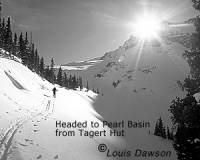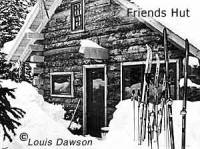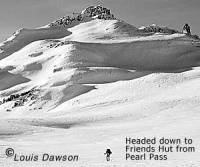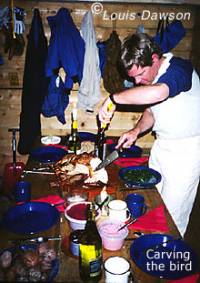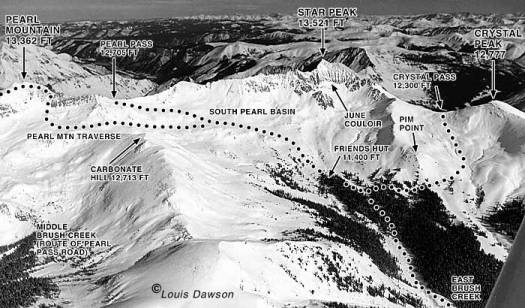Our friend Graeme called in late October to suggest that we have Thanksgiving dinner at a high Colorado hut. Graeme’s fiance was along, as well as outdoorsman Ted Kerasote and his friend Deb. Along with me and my wife Lisa we had a six person team to prepare, haul, then enjoy a holiday feast.
Picture Thanksgiving in the heart of Colorado ski country. The ski lifts open. Then you feast after a fine day of glisse. Yet imagine more — dream something unique. Imagine you click into your touring skis early Thanksgiving morning. You glide though pristine forest and high alpine bowls to a mountain chalet. You sit down to a full turkey dinner in the midst of stupendous wilderness. Huge peaks rise outside your door. A soft snow falls. Fire glows in the woodstove.
Fantasy? Nope, it really happens — every winter hundreds of people do it. Here in central Colorado you can pick from scores of backcountry ski “huts.” These structures range from palatial chalets to snug cabins. Most have solar-powered electric lights, cozy wood-burner heat, and views that lock your eyes like a fine painting. Thousands of people trek from from hut to hut with nothing more than a backpack and a smile.
And at no other time are those smiles grander than during the winter holidays. New Years, Christmas, Thanksgiving; it’s become a tradition to haul your goodies to a hut.
I remember one Thanksgiving that dawned clear and blue in the Roaring Fork valley. The ski lifts of The Aspens were set to open, while thousands of birds were readied for the traditional feast. Our turkey was no exception, but it had been divided between six people and packed for a ten mile ski tour.
In the dawn hours we parked at the upper end of the Castle Creek road and saddled up. I’ll admit we were a bit overloaded; we joked about being a “walking delicatessen”. Several bottles of fine Chardonnay gurgled in Ted’s pack. A tangle of French bread loaves and extra clothing sprouted from my wife’s load. Tupperware dug into my spine. All the goodies in that pack are worth it — at least that’s what I kept telling myself.
Our big goal was Pearl Pass (see photo below), at 12,500 feet the high point of the trip. About 3/4 of our travel time would be spent getting to the top of the pass. Once we topped the pass we’d be able to downhill ski two miles to Friends Hut, one of the most beautiful backcountry cabins in Colorado. We spoke of the old mining days as we skied. Pearl is one of the highest jeep road passes in the state. The road was built more than 100 years ago to bring coke made from the coal mined in Crested Butte to the Smelters in Aspen. In those days the pass was open all winter. The wagons using the pass had custom blades attached to the sides of their wheels to cut the ever encroaching drifts back during each trip over. The pass was also skied quite often in those days both by individuals looking for their fortune and the mail carriers of the day. Many of these individuals were lost in avalanches.
The route got steeper and we put climbing skins (strips of special fur) on our ski bottoms. Skiing uphill with skins feels terrific. The smooth rhythm lets you enjoy the view, or ponder the world. You can answer all life’s great questions in three hours of “skinning”. Lisa and Gail, both beginner backcountry skiers, looked like seasoned pros as they made the smooth short steps and resolute pole plants distinctive of the climbing skin gait.
Our route took us up through some avalanche gnarled aspen forests then crossed Castle Creek over a small foot bridge. We’d traveled about 5 miles and The sun had just began to catch us when we passed the first hut on the route . This is the Toklat Chalet, built by the Mace family who were longtime valley residents. Toklat is a solid looking stone structure nestled in the pines just a few hundred feet from a major avalanche slope. As we passed the Toklat Chalet we kept a wary eye up on the left as we crossed under several major avalanche paths. Though the chance of a natural avalanche release occurring at the exact time you’re underneath the path is minimal, we still traveled one at a time and payed attention to our surroundings.
A few miles past the Toklat Chalet, we reached the Tagert Hut. This hut was one of the first ski huts in Colorado, and has been in use since the 1940’s (though rebuilt once after a fire). We took a short break on the porch, fed a few treats to the ubiquitous jay birds, and gazed at the awesome mountain faces that seemed to rise from our feet to forever. The setting is intimidating, but our route followed a sort of high alpine “shelf” that avoided scaling the big peaks.
From the porch of the Tagert we climbed up to timberline and entered enormous Pearl Basin. This huge area of wind sculpted alpine snow makes route finding for the newcomer quite difficult. Since the jeep road is usually hidden by snow the problem is identifying Pearl Pass, which you find hidden behind a shoulder of Pearl Mountain after crossing below three false passes, all of which have been mistakenly skied over at one time or another. Having skied the route several times before, we all had a good idea where to go, but that didn’t stop us from checking the map a few times, as experience is a harsh but effective teacher. I couldn’t help but remember the time a friend and I had skied over the wrong pass and ended up cliffed in the wrong drainage. It took us a long time to get to Crested Butte.
This gigantic alpine area is all you expect of Colorado above the timber. Jagged peaks rise in every direction while pristine snow lures you ever deeper. It can be a tough environment. Yet you might see a Ptarmigan bird fly from the snow, and when the air is still you can ski in your shirt sleeves. We were lucky, and a classic Colorado “blue sky day” stayed with us as we wound through the basin. Without a wisp of wind, I could hear everyone’s skis whisper through the fresh cotton-candy snow.
Our packs were heavy, so it was a relief to finally hit Pearl Pass. You can see the hut below the pass, so the stunning views don’t stop you for long. The run down to the hut can be terrific — or it can be a fight. It all depends on snow conditions. After all, you won’t find any grooming machines up there! It helps to repeat the mantra, “there is no bad snow, only bad skiers”. We had mediocre snow — but the harder the turns the more we laughed.
We claimed bunks and unpacked gear. The wood-stove crackled as we lay out our feast. I knew that bearing the torture of my Tupperware would be a good deed — it was full of home-made cranberry sauce. We buttered the bread loves and put them on the stove to warm. Our places were set on the trestle table, and we sipped wine while the turkey warmed. As we sat together, we felt a closeness that you can only get in a place with no television, no cars — and miles of wilderness in every direction.
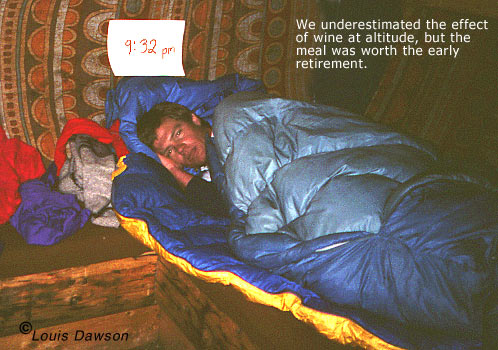
High altitude, but he rose and skied!
WildSnow.com publisher emeritus and founder Lou (Louis Dawson) has a 50+ years career in climbing, backcountry skiing and ski mountaineering. He was the first person in history to ski down all 54 Colorado 14,000-foot peaks, has authored numerous books about about backcountry skiing, and has skied from the summit of Denali in Alaska, North America’s highest mountain.

